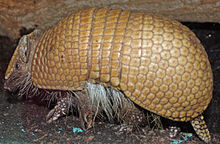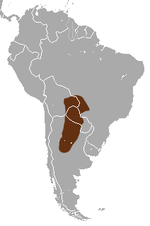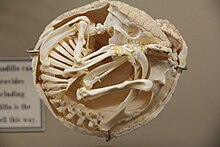339:
31:
80:
226:
55:
349:
296:, the same protein that builds human fingernails. They are typically a yellow or brownish color. They are among the smaller armadillos, with a head-and-body length of about 22 to 27 cm (8.7 to 10.6 in) and a weight between 1 and 1.6 kg (2.2 and 3.5 lb). Unlike most armadillos, they are not
212:
292:). The three characteristic bands that cover the back of the animal allow it enough flexibility to fit its tail and head together, allowing it to protect its underbelly, limbs, eyes, nose and ears from predators. The shell covering its body is armored and the outer layer is made out of
1270:
1124:
1230:
1189:
307:
The three-banded armadillo has a long, sticky, straw-like pink tongue that allows it to gather up and eat many different species of insects, typically
1098:
1137:
464:
524:
1240:
1163:
962:
285:
1265:
902:
872:
338:
1181:
892:
882:
1142:
1245:
666:
1260:
676:
1250:
1176:
1059:
706:
201:
446:
427:
79:
1255:
1194:
696:
774:
603:
594:
517:
1037:
999:
764:
716:
211:
1064:
686:
184:
1085:
1046:
809:
800:
628:
619:
502:
30:
1235:
983:
784:
405:
319:
288:, are the only species of armadillos capable of rolling into a complete ball to defend themselves (
230:
44:
510:
74:
1129:
1202:
1072:
726:
470:
460:
1051:
454:
1207:
400:
1155:
927:
918:
59:
755:
584:
301:
225:
141:
492:
1224:
1150:
450:
391:
382:
258:
64:
1077:
853:
745:
151:
1168:
1111:
1031:
943:
323:
161:
863:
574:
534:
474:
348:
297:
289:
262:
254:
131:
91:
1022:
1016:
568:
562:
556:
315:. In captivity, armadillos also eat foods such as fruits and vegetables.
312:
270:
111:
1103:
657:
647:
293:
274:
280:
The southern three-banded armadillo and the other member of the genus
1116:
550:
266:
121:
101:
993:
834:
825:
347:
337:
224:
456:
Mammal
Species of the World: A Taxonomic and Geographic Reference
459:(3rd ed.). Johns Hopkins University Press. pp. 98–99.
308:
1090:
997:
506:
376:
374:
372:
370:
277:, at elevations from sea level to 770 m (2,530 ft).
326:
to farmland, and from hunting for food and the pet trade.
38:
Southern three-banded armadillo at the
Louisville Zoo
1006:
941:
916:
861:
852:
823:
798:
753:
744:
655:
646:
617:
592:
583:
229:
Three banded armadillo skeleton rolled in a ball. (
406:10.2305/IUCN.UK.2014-1.RLTS.T21974A47443233.en
518:
8:
381:Noss, A.; Superina, M.; Abba, A.M. (2014).
994:
858:
750:
652:
589:
525:
511:
503:
352:Individual rolled up into a defensive ball
210:
53:
29:
20:
404:
486:
484:
366:
342:Individual in the process of curling up
1271:Taxa named by Anselme Gaëtan Desmarest
219:Southern three-banded armadillo range
1231:IUCN Red List near threatened species
7:
392:IUCN Red List of Threatened Species
261:. It is found in parts of northern
14:
428:"Southern three-banded armadillo"
963:Brazilian three-banded armadillo
286:Brazilian three-banded armadillo
78:
24:Southern three-banded armadillo
953:Southern three-banded armadillo
903:Southern naked-tailed armadillo
873:Northern naked-tailed armadillo
247:La Plata three-banded armadillo
239:southern three-banded armadillo
893:Greater naked-tailed armadillo
883:Chacoan naked-tailed armadillo
322:from conversion of its native
1:
667:Southern long-nosed armadillo
318:The species is threatened by
677:Greater long-nosed armadillo
707:Llanos long-nosed armadillo
1287:
697:Hairy long-nosed armadillo
1241:Mammals described in 1804
980:
775:Screaming hairy armadillo
545:
300:, but will use abandoned
218:
209:
190:
183:
75:Scientific classification
73:
51:
42:
37:
28:
23:
604:Greater fairy armadillo
496:Retrieved 14 June 2014.
251:Azara's domed armadillo
1266:Myrmecophagous mammals
765:Andean hairy armadillo
717:Seven-banded armadillo
453:; Reeder, D.M (eds.).
445:Gardner, A.L. (2005).
353:
343:
234:
687:Nine-banded armadillo
399:: e.T21974A47443233.
351:
341:
228:
1246:Mammals of Argentina
810:Six-banded armadillo
629:Pink fairy armadillo
540:species by subfamily
1261:Mammals of Paraguay
785:Big hairy armadillo
493:Tolypeutes matacus.
320:habitat destruction
231:Museum of Osteology
45:Conservation status
1251:Mammals of Bolivia
1052:Tolypeutes matacus
1038:Tolypeutes matacus
1008:Tolypeutes matacus
490:Armadillo Online:
385:Tolypeutes matacus
354:
344:
243:Tolypeutes matacus
235:
194:Tolypeutes matacus
1256:Mammals of Brazil
1218:
1217:
1203:Open Tree of Life
1000:Taxon identifiers
991:
990:
976:
975:
848:
847:
740:
739:
642:
641:
538:
466:978-0-8018-8221-0
447:"Order Cingulata"
358:
357:
245:), also known as
223:
222:
68:
16:Type of Armadillo
1278:
1211:
1210:
1198:
1197:
1185:
1184:
1172:
1171:
1159:
1158:
1146:
1145:
1133:
1132:
1120:
1119:
1107:
1106:
1094:
1093:
1081:
1080:
1068:
1067:
1055:
1054:
1042:
1041:
1040:
1027:
1026:
1025:
995:
859:
751:
721:D. septemcinctus
653:
590:
536:
527:
520:
513:
504:
497:
488:
479:
478:
442:
436:
435:
424:
418:
417:
415:
413:
408:
378:
334:
333:
214:
196:
83:
82:
62:
57:
56:
33:
21:
1286:
1285:
1281:
1280:
1279:
1277:
1276:
1275:
1221:
1220:
1219:
1214:
1206:
1201:
1193:
1188:
1180:
1175:
1167:
1162:
1154:
1149:
1141:
1136:
1128:
1123:
1115:
1110:
1102:
1097:
1089:
1084:
1076:
1071:
1063:
1058:
1050:
1045:
1036:
1035:
1030:
1021:
1020:
1015:
1002:
992:
987:
972:
937:
928:Giant armadillo
912:
844:
819:
794:
736:
691:D. novemcinctus
638:
613:
595:Calyptophractus
579:
541:
531:
501:
500:
489:
482:
467:
444:
443:
439:
432:Xenarthrans.org
426:
425:
421:
411:
409:
380:
379:
368:
363:
332:
265:, southwestern
205:
198:
192:
179:
176:T. matacus
77:
69:
60:Near Threatened
58:
54:
47:
17:
12:
11:
5:
1284:
1282:
1274:
1273:
1268:
1263:
1258:
1253:
1248:
1243:
1238:
1233:
1223:
1222:
1216:
1215:
1213:
1212:
1199:
1186:
1173:
1160:
1147:
1134:
1121:
1108:
1095:
1082:
1069:
1056:
1043:
1028:
1012:
1010:
1004:
1003:
998:
989:
988:
981:
978:
977:
974:
973:
971:
970:
960:
949:
947:
939:
938:
936:
935:
924:
922:
914:
913:
911:
910:
900:
890:
880:
869:
867:
856:
850:
849:
846:
845:
843:
842:
831:
829:
821:
820:
818:
817:
806:
804:
796:
795:
793:
792:
782:
772:
761:
759:
756:Chaetophractus
748:
742:
741:
738:
737:
735:
734:
731:Dasypus yepesi
727:Yepes's mulita
724:
714:
704:
694:
684:
674:
663:
661:
650:
644:
643:
640:
639:
637:
636:
625:
623:
615:
614:
612:
611:
600:
598:
587:
585:Chlamyphorinae
581:
580:
578:
577:
571:
565:
559:
553:
546:
543:
542:
532:
530:
529:
522:
515:
507:
499:
498:
480:
465:
437:
419:
365:
364:
362:
359:
356:
355:
345:
331:
328:
302:giant anteater
221:
220:
216:
215:
207:
206:
199:
188:
187:
181:
180:
173:
171:
167:
166:
159:
155:
154:
149:
145:
144:
142:Chlamyphoridae
139:
135:
134:
129:
125:
124:
119:
115:
114:
109:
105:
104:
99:
95:
94:
89:
85:
84:
71:
70:
52:
49:
48:
43:
40:
39:
35:
34:
26:
25:
15:
13:
10:
9:
6:
4:
3:
2:
1283:
1272:
1269:
1267:
1264:
1262:
1259:
1257:
1254:
1252:
1249:
1247:
1244:
1242:
1239:
1237:
1234:
1232:
1229:
1228:
1226:
1209:
1204:
1200:
1196:
1191:
1187:
1183:
1178:
1174:
1170:
1165:
1161:
1157:
1152:
1148:
1144:
1139:
1135:
1131:
1126:
1122:
1118:
1113:
1109:
1105:
1100:
1096:
1092:
1087:
1083:
1079:
1074:
1070:
1066:
1061:
1057:
1053:
1048:
1044:
1039:
1033:
1029:
1024:
1018:
1014:
1013:
1011:
1009:
1005:
1001:
996:
986:
985:
979:
968:
967:T. tricinctus
964:
961:
958:
954:
951:
950:
948:
946:
945:
940:
933:
929:
926:
925:
923:
921:
920:
915:
908:
907:C. unicinctus
904:
901:
898:
894:
891:
888:
887:C. chacoensis
884:
881:
878:
874:
871:
870:
868:
866:
865:
860:
857:
855:
851:
840:
836:
833:
832:
830:
828:
827:
822:
815:
814:E. sexcinctus
811:
808:
807:
805:
803:
802:
797:
790:
786:
783:
780:
779:C. vellerosus
776:
773:
770:
766:
763:
762:
760:
758:
757:
752:
749:
747:
743:
732:
728:
725:
722:
718:
715:
712:
711:D. sabanicola
708:
705:
702:
698:
695:
692:
688:
685:
682:
678:
675:
672:
668:
665:
664:
662:
660:
659:
654:
651:
649:
645:
634:
630:
627:
626:
624:
622:
621:
616:
609:
605:
602:
601:
599:
597:
596:
591:
588:
586:
582:
576:
572:
570:
566:
564:
560:
558:
554:
552:
548:
547:
544:
539:
528:
523:
521:
516:
514:
509:
508:
505:
495:
494:
487:
485:
481:
476:
472:
468:
462:
458:
457:
452:
448:
441:
438:
433:
429:
423:
420:
407:
402:
398:
394:
393:
388:
386:
377:
375:
373:
371:
367:
360:
350:
346:
340:
336:
335:
329:
327:
325:
321:
316:
314:
310:
305:
303:
299:
295:
291:
287:
283:
278:
276:
272:
268:
264:
260:
259:South America
257:species from
256:
252:
248:
244:
240:
232:
227:
217:
213:
208:
203:
197:
195:
189:
186:
185:Binomial name
182:
178:
177:
172:
169:
168:
165:
164:
160:
157:
156:
153:
150:
147:
146:
143:
140:
137:
136:
133:
130:
127:
126:
123:
120:
117:
116:
113:
110:
107:
106:
103:
100:
97:
96:
93:
90:
87:
86:
81:
76:
72:
66:
61:
50:
46:
41:
36:
32:
27:
22:
19:
1007:
982:
966:
956:
952:
942:
931:
917:
906:
896:
886:
877:C. centralis
876:
862:
854:Tolypeutinae
838:
824:
813:
799:
788:
778:
768:
754:
746:Euphractinae
730:
720:
710:
700:
690:
680:
670:
656:
633:C. truncatus
632:
620:Chlamyphorus
618:
607:
593:
537:(Armadillos)
491:
455:
451:Wilson, D.E.
440:
431:
422:
410:. Retrieved
396:
390:
384:
317:
306:
281:
279:
250:
246:
242:
238:
236:
193:
191:
175:
174:
162:
152:Tolypeutinae
18:
1112:iNaturalist
1032:Wikispecies
789:C. villosus
681:D. kappleri
671:D. hybridus
648:Dasypodinae
573:Superorder
567:Infraclass
412:19 November
148:Subfamily:
1236:Armadillos
1225:Categories
957:T. matacus
944:Tolypeutes
932:P. maximus
919:Priodontes
897:C. tatouay
801:Euphractus
769:C. nationi
701:D. pilosus
608:C. retusus
535:Cingulata
361:References
282:Tolypeutes
163:Tolypeutes
864:Cabassous
839:Z. pichiy
575:Xenarthra
324:Dry Chaco
304:burrows.
298:fossorial
290:volvation
263:Argentina
255:armadillo
202:Desmarest
170:Species:
132:Cingulata
98:Kingdom:
92:Eukaryota
1182:11700053
1130:10595494
1017:Wikidata
984:Category
569:Eutheria
563:Mammalia
557:Chordata
551:Animalia
549:Kingdom
475:62265494
313:termites
271:Paraguay
253:, is an
138:Family:
122:Mammalia
112:Chordata
108:Phylum:
102:Animalia
88:Domain:
65:IUCN 3.1
1169:1000419
1104:2440792
826:Zaedyus
658:Dasypus
555:Phylum
533:Extant
330:Gallery
294:keratin
275:Bolivia
204:, 1804)
158:Genus:
128:Order:
118:Class:
63: (
1208:515354
1195:183749
1143:624905
1091:328498
1065:379186
1023:Q75070
561:Class
473:
463:
284:, the
267:Brazil
1156:21974
1125:IRMNG
1117:47081
1078:7CFJZ
835:Pichi
449:. In
1190:NCBI
1151:IUCN
1138:ITIS
1099:GBIF
1060:BOLD
471:OCLC
461:ISBN
414:2021
397:2014
311:and
309:ants
273:and
237:The
1177:MSW
1164:MDD
1086:EoL
1073:CoL
1047:ADW
401:doi
249:or
1227::
1205::
1192::
1179::
1166::
1153::
1140::
1127::
1114::
1101::
1088::
1075::
1062::
1049::
1034::
1019::
483:^
469:.
430:.
395:.
389:.
369:^
269:,
969:)
965:(
959:)
955:(
934:)
930:(
909:)
905:(
899:)
895:(
889:)
885:(
879:)
875:(
841:)
837:(
816:)
812:(
791:)
787:(
781:)
777:(
771:)
767:(
733:)
729:(
723:)
719:(
713:)
709:(
703:)
699:(
693:)
689:(
683:)
679:(
673:)
669:(
635:)
631:(
610:)
606:(
526:e
519:t
512:v
477:.
434:.
416:.
403::
387:"
383:"
241:(
233:)
200:(
67:)
Text is available under the Creative Commons Attribution-ShareAlike License. Additional terms may apply.


